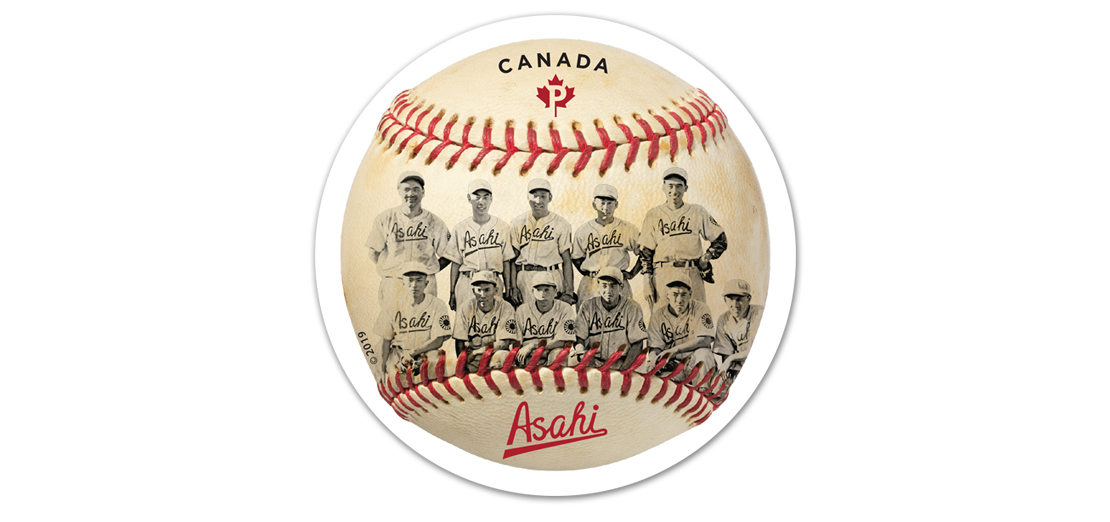The sole survivor of historic Japanese-Canadian baseball team unveiled the stamp honouring the Vancouver Asahi.
When the last surviving members of the Vancouver Asahi were introduced at the 2003 Canadian Baseball Hall of Fame inductee dinner, the crowd stood for five elderly Japanese-Canadian men and applauded for what seemed an eternity. The heartfelt welcome reduced each of the men to tears.
Sixteen years later, Kaye Kaminishi, the sole surviving member of the original Asahi, has just unveiled Canada Post’s latest stamp at the Nikkei National Museum & Cultural Centre in Burnaby, B.C. The stamp honours the venerable team that left its mark on the North American game and instilled Japanese Canadians with hope.

The 1940 Asahi team photo that adorns the baseball-shaped stamp features a teenage Kaminishi and 10 teammates. Kaminishi, 97, appears in the back row, second from left, as well as on another photo on the stamp booklet cover.
Seeing the last Asahi beaming in front of the enlargement, it is easy to see the resemblance to his younger self.
The Asahi’s “brain ball” helped win several baseball championships
The Vancouver Asahi was an amateur Japanese-Canadian baseball team that captured headlines with a unique style of play known as “brain ball.” The strategy was developed by Harry Miyasaki, a Powell Street dry cleaner who dreamed of fielding a team that could defeat other Canadian clubs in the city.
His strategy relied heavily on bunts, base stealing and squeeze plays to manufacture runs – and wins. So successful was the style that the team once won a game 3-1 without technically getting a hit.
Canada Post’s latest stamp tells the “brain ball” story, as well as how the Asahi helped to remove racial barriers through sport. It is a story about ganbare – the determination to overcome racism and discrimination without retaliation, through sportsmanship and fair-play.
While white fans and opponents heckled and called them names, the Asahi players let their actions on the field do the talking.
Led by legendary players like Junji Ito (The King of Bunting), Roy Yamamura, and Tom Matoba, the Asahi won the Terminal League title in 1926 and its first Terminal League Championship. It would win three more by 1933 – and five consecutive Pacific Northwest Championships from 1937 to 1941.
The team became a source of great pride for Japanese Canadians, and the top baseball gate attraction on the West Coast. Hopeful recruits came from every surrounding town in the Fraser Valley. Wearing the Asahi uniform was the dream of virtually every Japanese Canadian boy, including Kaye Kaminishi.
Growing up across the street from Powell Grounds in a rooming house his mother owned and operated, Kaminishi went to every Asahi game. He played in a church league before graduating to the Japanese League and then to the Asahi in 1939. He was the youngest player on the team.
The Vancouver Asahi baseball team was a source of pride
Japanese Canadians loved the game because it was a big part of the North American culture from which they were largely excluded; and it was affordable for working-class families. Baseball was the social backdrop of their lives.
On game days, businesses closed and schools were let out early. If there happened to be a Sunday game, the church was empty, too. People filled the grandstands, then lined the streets around Oppenheimer Park at the Powell Street Grounds.
That ended when Japan attacked Pearl Harbor in December 1941. Canada declared war on Japan and interned 22,000 Canadians of Japanese descent in camps in B.C.’s Interior. As a team, the Asahi would never play together again.
Given 24 to 48 hours to collect whatever they could carry with them in a couple of bags, Asahi players packed their baseball gloves and uniforms.
The Vancouver Asahi’s players are honoured as part of Japanese-Canadian history
Since 2003, the Asahi was inducted into the British Columbia Sports Hall of Fame (2005); Oppenheimer Park was designated a National Historic Site (2008); and several books and films about the team have been produced, along with a Heritage Minute by Historica Canada (2019).
At the Canadian Baseball Hall of Fame event, Kiyoshi Suga, a star with the Asahi in the 1930s, said that the crowd’s acceptance and team’s induction were the “ultimate validation for everything that has happened.”
In a separate speech at the induction ceremony, Kutsukake described Canada as “the greatest country in the world in which to live!”
Back at the Nikkei Museum on April 24, 2019, the last Asahi is mingling with the 250 people drawn to see him and celebrate his team. To see him joking with boys from the Asahi Baseball Association, an organization inspired by the original team, is to understand what historian Greg Robinson meant when he labelled the internment a tragic story with a happy ending.
For Kaye Kaminishi, it has been a story for the ages.
Stamp immortalizes Japanese-Canadian baseball team
Available now